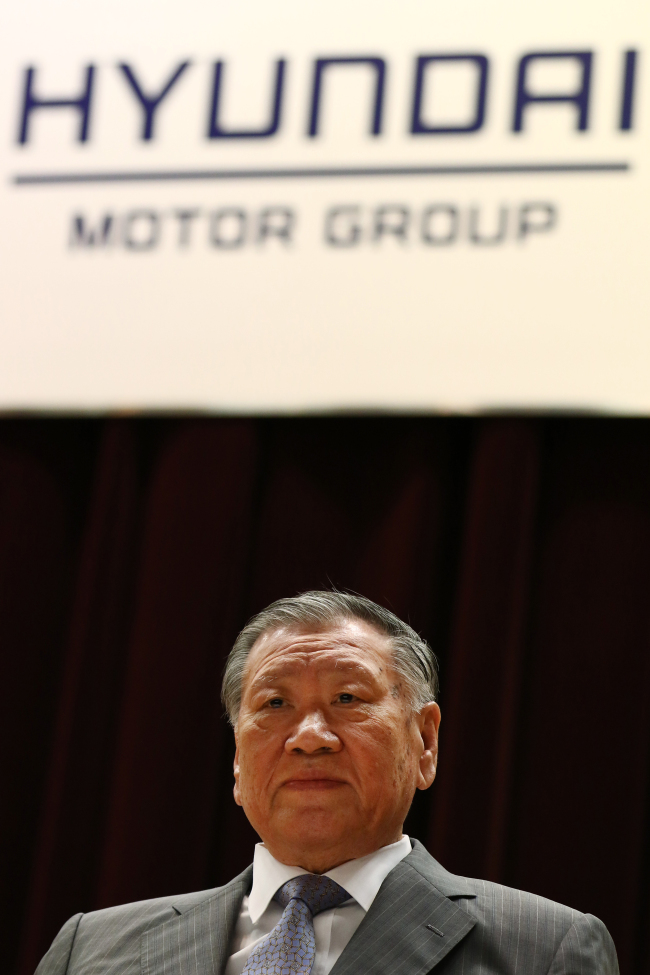Hyundai-Kia forecasts slowest sales gain in 9 years
By Korea HeraldPublished : Jan. 4, 2015 - 21:35
Hyundai Motor and Kia Motors, South Korea’s largest automakers, forecast their weakest sales growth in nine years as they run out of capacity to increase output and competition intensifies in major markets.
The companies’ combined deliveries will rise 2.5 percent to 8.2 million vehicles in 2015, Chung Mong-koo, chairman of both automakers, said during a New Year address to employees in Seoul on Friday. That would be the slowest growth since 2006. The forecast was in line with the median estimate of 8.2 million units in a Bloomberg News survey of five analysts.
The companies’ combined deliveries will rise 2.5 percent to 8.2 million vehicles in 2015, Chung Mong-koo, chairman of both automakers, said during a New Year address to employees in Seoul on Friday. That would be the slowest growth since 2006. The forecast was in line with the median estimate of 8.2 million units in a Bloomberg News survey of five analysts.

Hyundai and Kia will “actively respond” to global economic uncertainties and a weaker yen that gives Japanese competitors an advantage, and will be able to “easily” meet the 2015 target, said Chung, 76. The carmakers plan to increase production by a combined 38 percent in China by 2018 to meet demand, and have introduced updated versions of sport utility vehicles Tucson and Sportage to maintain their market share.
“The carmakers will have a slow 2015 as they both have no room to increase output with no new plants or expansions planned for the year,” Koh Tae-bong, an analyst at HI Investment & Securities Co. in Seoul, said before Chung’s comments. “What’s key for the coming year is maintaining market share and gauging how well the biggest markets react to their new SUV models.”
Hyundai plans to increase sales by 1.7 percent to 5.05 million vehicles in 2015, while Kia’s aim is for a 3.6 percent increase to 3.15 million units, the companies said in separate filings on Friday.
Shares of Hyundai and Kia were both unchanged at the close in Seoul. South Korea’s Kospi index rose 0.6 percent.
Hyundai and its Chinese partner BAIC Motor Corp. will expand production in China by 57 percent by adding two plants with annual output capacity of 300,000 vehicles each in Chongqing city and Changzhou, Hebei province, they said Dec. 30.
Kia will increase capacity at its third China plant in Jiangsu province to 450,000 units by 2016 from the current 300,000.
Hyundai produced more than 1 million vehicles in China in the first 11 months of 2014, up 7.6 percent from a year earlier, placing it on course to meet an annual output target of 1.08 million units. Kia built 610,711 vehicles in the January-to-November period, compared with its full-year production target of 630,000.
Shares of Hyundai and Kia have fallen 22 percent and 11 percent respectively since Sept. 17, the day before Korea Electric Power Corp. said Hyundai Motor Group had won an auction for a prime property owned by the state-run company in South Korea’s central Gangnam district. The winning bid was 10.6 trillion won ($9.6 billion), triple the assessed price.
Winning the land auction shows how much the group’s image has improved and will help Hyundai and Kia sales globally, Chung said Friday.
Hyundai will pay 55 percent of the total price for the land, followed by Hyundai Mobis with 25 percent and Kia the remainder. Hyundai group has said its plans for the site include a hotel, convention center and auto theme park.
The group also intends to move 30 of its affiliates to the site, which will house the new headquarters of Hyundai and Kia.
The two carmakers and affiliate Mobis lost $16 billion in combined market value from Sept. 17 through Dec. 30, the last trading day of 2014.
To help ease investor discontent, Lee Won-hee, Hyundai’s chief financial officer, and Park Han-woo, Kia’s current chief executive officer and former CFO, both said in October that the companies are considering an interim dividend payout. The automakers said in November that they plan to spend 670 billion won to buy back stock by Feb. 11 this year. (Bloomberg)
-
Articles by Korea Herald








![[KH Explains] Hyundai-backed Motional’s struggles deepen as Tesla eyes August robotaxi debut](http://res.heraldm.com/phpwas/restmb_idxmake.php?idx=644&simg=/content/image/2024/05/16/20240516050605_0.jpg&u=20240516155018)










